"Cosa ha detto il dottore?" Idee e riflessioni per una comunicazione efficace tra medico e paziente migrante
Titolo Rivista SALUTE E SOCIETÀ
Autori/Curatori Maria Laura Russo, Fabrizia Petri, Maurizio Marceca
Anno di pubblicazione 2013 Fascicolo 2013/1
Lingua Italiano Numero pagine 23 P. 141-163 Dimensione file 1154 KB
DOI 10.3280/SES2013-001011
Il DOI è il codice a barre della proprietà intellettuale: per saperne di più
clicca qui
Qui sotto puoi vedere in anteprima la prima pagina di questo articolo.
Se questo articolo ti interessa, lo puoi acquistare (e scaricare in formato pdf) seguendo le facili indicazioni per acquistare il download credit. Acquista Download Credits per scaricare questo Articolo in formato PDF

FrancoAngeli è membro della Publishers International Linking Association, Inc (PILA)associazione indipendente e non profit per facilitare (attraverso i servizi tecnologici implementati da CrossRef.org) l’accesso degli studiosi ai contenuti digitali nelle pubblicazioni professionali e scientifiche
The article reflects about the dynamics of communication between doctor and patient, in particular migrants patient. The analysis starts from considering the possible benefits that the use of pictograms would bring to the goal of enhancing the therapeutic alliance between doctors and patients, positively affecting the processes of attention, comprehension, recall, and adherence. The images used for this purpose, however, have to be culturally sensitive, this can be achieved with a participative process that involves migrant in each step, from the initial drawing to the evaluation of the chosen tools of communication. It is important to emphasize the value of involving migrant in the therapeutic relationship in order to start an empowerment process that will be a significant step towards counterbalancing the evident disparity of migrants’ health.
Parole chiave:Comunicazione medico/paziente, health literacy, pittogrammi, paziente straniero, empowerment, partecipazione
Maria Laura Russo, Fabrizia Petri, Maurizio Marceca, "Cosa ha detto il dottore?" Idee e riflessioni per una comunicazione efficace tra medico e paziente migrante in "SALUTE E SOCIETÀ" 1/2013, pp 141-163, DOI: 10.3280/SES2013-001011